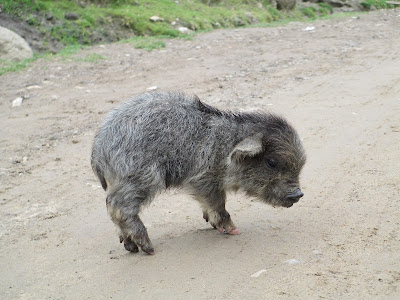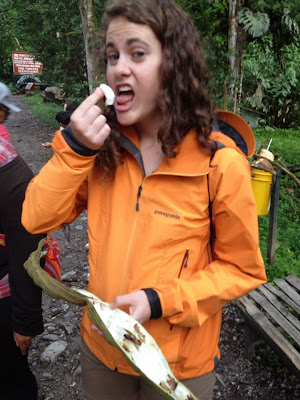THE PROVINCE OF HUANCAVELICA

I got the opportunity to travel to the province of
Huancavelica a couple of weeks ago now, leaving on Sunday, December 8th, at
7:30pm on an overnight bus and arriving back in Lima on Sunday, December 15th,
at 5:30am after traveling all night. I went with Daniela, my coworker with fair
trade, to visit the artisan groups that live in this area. One of the groups
lives in the city of Huancavlica, and the other three groups live in the tiny
district of Yauli, about 40 minutes by car from the city of Huancavelica. The
purpose of these visits was to get to know the artisans face to face, since we
only ever get to talk to the leader of the groups on the phone or through
email, and offer workshops for the groups to help them think about how this
past year went production-wise (quality control, efficiency, timeliness, etc.)
and make suggestions for how they can improve in this next year. I led the more
social aspect of the workshop and did a couple activities to help them
construct what it means to be a part of a team and be a leader within the
group.
 |
| El Mercurio. Huancavelica. |
 |
| Sumacc Ruraq. Yauli. |
 |
| Tupac Yupanqui. Yauli. |
 |
| A possible new group: Achkamaki. Yauli. |
It was a much to different experience than being in Lima,
both in working with the artisans and in life in general. I loved it though… especially Yauli! Here
are some notes on my experience:
LANDSCAPE/WEATHER: We were high up in the Andes Mountains - more
than 3,600 meters (>13,000 feet). I’ve traveled to this altitude several
times now so I don’t feel it too much, but the lack of oxygen in the air was
definitely noticeable as we did a little hiking around. It is gorgeous here!
They are in the rainy season there (somehow it works so that certain areas of
the country are in winter even while Lima is entering into summer), so
everything had a soft coat of green grass. There were lots of open pastures for
sheep and cows scattered around and people had squares of farmland where they
grow mostly native potatoes. This region of the country is known for its
potatoes. There are supposedly more than 3,000 varieties of potatoes grown
here! The weather felt like a mix of fall and spring in the northwest. The days
were chilly and crisp with the sun peeking out and offering warmth here and
there, interspersed with a fresh rain that nourished the rich soil but also
made everything muddy. We had to expect any and all types of weather at all
times.
 |
| Old church in Huancavelica. |
 |
| View up the river in Huancavelica. |
 |
| View of the mountains in Yauli. |
 |
| Beautiful little waterfall and cow pasture next to the river in Yauli. |
 |
| Cute little runt pig! |
LANGUAGE: In this area of the country pretty much everybody
speaks Quechua. In Huancavelica most people also speak Spanish fluently and for
many it is their first language. There were still a couple artisans we worked
with that could not respond to us in Spanish. They understood everything we
were saying but would respond in Quechua and someone would have to translate.
However, among the people I met in Yauli, I think everyone’s first language was
Quechua, and if they spoke Spanish, it was something they didn’t begin learning
until later. Many people still didn’t understand Spanish well let alone were
able to speak it. The accent of Spanish I heard in Yauli was really strange as well
and made it difficult for me to understand at times. (For example, a lot of the
‘e’ vowels in Spanish end up sounding like an ‘i.’ Also, most of the r’s that
come at the end of words sound more like ‘rsh.’) I joked with Daniela that I
was having a hard time distinguishing even when the artisans were speaking
Spanish and when they were speaking Quechua because their accent was so thick.
They also had a harder time understanding me than most people I encounter in
Lima. It was interesting trying to navigate this difficulty.
DRESS: There was not a single woman that was from Yauli
itself that did not wear traditional dress. Some wore more elements than
others, but at the very least everyone wore their outer skirt with deep pockets
to hold their knitting. Most wore everything: their leather shoes, leggings,
leg warmers, multiple skirts, multiple sweaters with a button-up sweater on the
outside, a manta or special decorated cloth covering their shoulders and pinned
in front (or the manta tied with a load or child on their back), two braids in
their hair tied together in the back, and a hat with flowers tucked in. As if I
didn’t stick out enough as a tall, white gringa already, without the
traditional dress I stood out even more in Yauli and literally drew prolonged
stares and dropped jaws with every step I took.
 |
| One of the women from Sumacc Ruraq. |
 |
| Selling potatoes in the main plaza of Yauli. |
LIFE: I love the simplicity of life in Yauli and the way
people work hard and walk long distances and end up looking weathered and like
they’ve put in their time. Most of the houses are constructed out of big chunks
of rock held together by mud and have a tile roof. Some of the houses have a
little cement, but mostly they are made out of natural materials. They have to
be sure to have a good roof, though, to protect from the rain and to keep the mud
from rewetting and washing away. The floors of the houses are often dirt.
Walking down the street during the afternoon when it wasn’t raining, I saw in
front of nearly every house at least one woman sitting on a stool or on the
curb knitting. They lined the streets. At first when we would ask the artisans
what they liked to do in their free time as a hobby and they would respond by
saying knitting, I didn’t think they had understood the question correctly. But
upon seeing that the pastime of women in this culture really is knitting, I
found that assumption corrected. It is standard practice to offer guests
something to eat. When we went to visit a group, they would provide us
potatoes, which you are supposed to peel by hand, cheese, and a hot (really really)
sweet tea. Even though they barely have enough resources to keep up with all
the kids that are running around, hospitality is top on the list of priorities.
 |
| The house of Ezequiel and his family from the group Tupac Yupanqui. |
 |
| An older woman leading her sheep home in the evening. |
 |
| They came right past us! |
OTHER PICS FROM HUANCAVELICA:
 |
| Luz. One of the children of a woman from El Mercurio. |
 |
| The workshop of Sumacc Ruraq. |
 |
| Jon Alex. The son of some of the founding members of Sumacc Ruraq. |
 |
| Girl from Sumacc Ruraq. |
CHRISTMAS CRAZINESS
First thing you need to know and understand about Peru at
Christmas time: panetón. The word literally means ‘big bread.’ I like to
describe it as that fruitcake that people always joke about old people serving
at their house. Peruvians are obsessed with their panetón and crave it like it
there’s no tomorrow around this time of year, although I still get that
fruitcake sensation every time I eat a piece. It is basically a fluffy cake
with raisins and red and green chunks of “real” dehydrated gummy watermelon. It
is common for people’s work to gift them a panetón for Christmas. Right now we
have three sitting in our house. Apparently all the bakeries stop making
regular bread on Christmas Eve and only sell panetón because they can make so
much more money by doing so and that’s all anyone wants anyway.
 |
| Three different brands of panetón. D'onofrio is probably the most popular. |
Coming back from Huancavelica I was thrown into the
Christmas craziness. This past week has been jam packed with activities and hot
chocolate and panetón. The thing to do around here is have what they call
‘chocolatadas.’ It is something that NGO’s or other organizations put on for
kids in poorer areas of the city. They have games, dancing, hot chocolate,
panetón, and usually a gift and/or a little goody bag for the kids. Bridge of
Hope put on a chocolatada for the kids in the neighborhood where the artisan
group Ima Sumacc yesterday. It was absolute chaos trying to coral these
sugared-up kids and be vigilant for the moms who don’t have money to buy their
kids a present and therefore are hiding their kid’s present so they can
hopefully get another. We were filling up baby bottles with hot chocolate and
kids were walking around double-fisting their panetón. My favorite age to
observe was the little toddlers!
 |
| The whole group. |
 |
| The boys team for one of the games. They tried hard... |
 |
| but the girls pulled a win! |
 |
| Our little "gordito." |
 |
| Cutest kid at the event hands down. |
For this event I went shopping in the center of Lima where
all the cheapest things can be bought. It is block after block of stores and
markets selling anything and everything. Each street is more or less designated
for a certain product, so you have to know where you are going. To name a few,
there’s an electronics area, kitchen, Chinatown, shoes, clothing, and where we
went, toys. There are Black Friday crowds every day fighting to get to the
front of the mob to buy 12 plastic toy cars for 24 soles or 12 plastic
Barbie-type dolls for 32 soles. Everything is sold in bulk and people
(including myself) are walking around holding black plastic garbage bags full
of toys over their heads trying to squeeze through the tiniest gap and advance
through the walkways of the market. The lowest level is the hottest (my guess
would be right around 105° F), but in none of the four levels do you ever stop sweating.
That being said there is MUCH less emphasis here on gift
giving. Kids do not expect huge piles of expensive gifts and the holiday has
not reached the levels of commercialization that it has in the U.S. The
tradition instead focuses more on the aspect of being together as a family and
sharing a good meal together. As long as there is something on the table and
someone to share it with, it is a good Christmas. Instead of presents being the
focus, the nativity and the coming of Jesus is still what takes center stage, as
it should.
I wish you all the merriest of Christmases and pray that God
may provide for you abundantly in this coming year. May there ever be enough
food on the table and good company to share it with!






